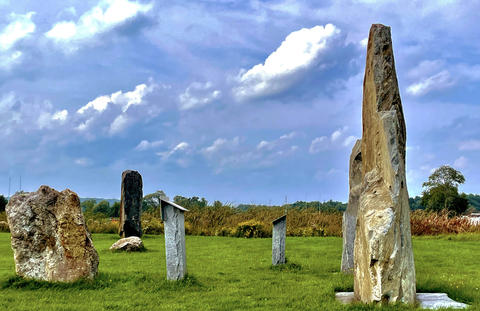Mark The Summer Solstice At The UMass Sunwheel

Standing stones at the UMass sunwheel. Photo: umass.edu
Source: UMass News and Media
The public is invited to join University of Massachusetts Amherst astronomers at the standing stones of the UMass Sunwheel on Wednesday, June 21 at 5 a.m. and 7:30 p.m. UMass Amherst astronomers will describe how the Sunwheel works and explain the astronomical cause of the solstice at the roughly hour-long gatherings.
This Sunwheel event marks the astronomical change of season when the day is longest and the night is shortest. UMass Amherst astronomer Stephen Schneider will discuss the astronomical cause of the solstice. Visitors will hear a presentation on the seasonal positions of Earth, the sun and moon, moon phases, building the Sunwheel and other calendar sites such as Stonehenge, Chankillo and Karnak. If it is clear, a solar telescope will be set up to safely observe the surface of the sun.
On the day of the June solstice, the sun reaches its farthest north position relative to the stars at 10:57 am EDT, which marks the astronomical start of summer in the Northern Hemisphere and winter in the Southern Hemisphere. On the date of the solstice, daylight is longest and nighttime is shortest in the Northern Hemisphere. The sun also reaches its highest point all year at local noon for everyone living north of the tropics. The sun passes straight overhead, on this day only, for people living along the Tropic of Cancer.
The Sunwheel’s standing stones mark the range of positions that the sun and moon rise and set throughout the year. On the date of the June solstice, the sun rises farthest northeast and sets farthest northwest at spots along the horizon marked by tall standing stones. Other stones mark the position of the sun at the equinoxes and winter solstice.
The position where the sun rises and sets on the horizon changes so gradually around the date of the solstice that it looks as though it is in the same place every day for more than a week. This is the origin of the word solstice, which means “stationary sun.” Sunwheel visitors who stop in on their own will be able to see the sun rising and setting over the summer solstice stones from roughly June 16-26.
The UMass Amherst Sunwheel is located south of McGuirk Alumni Stadium, just off Rocky Hill Road (Amity Street) about one-quarter mile south of University Drive. Visitors to the Sunwheel should be prepared for wet footing and mosquitoes. The events will be canceled in the event of heavy rain. For more info, please visit the Sunwheel website.
